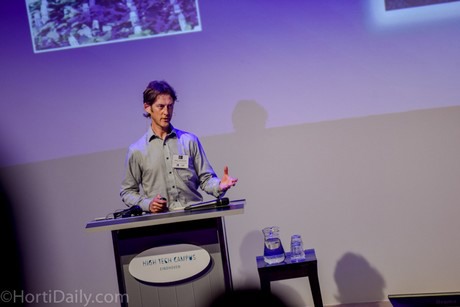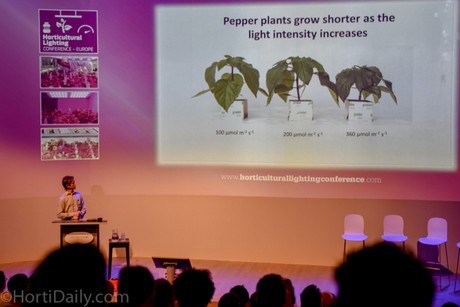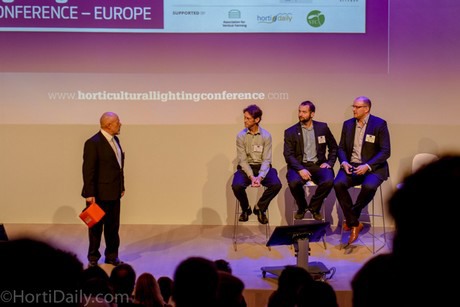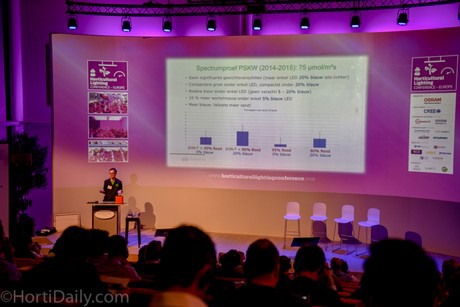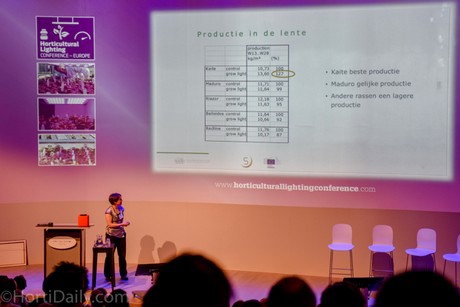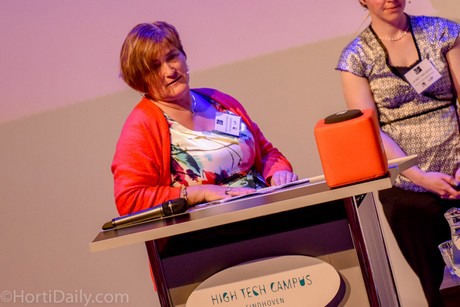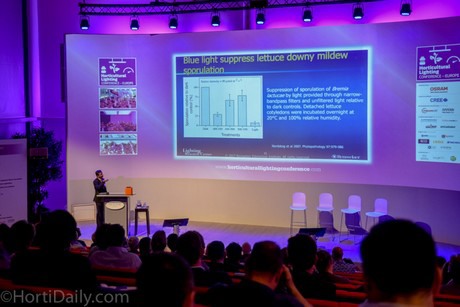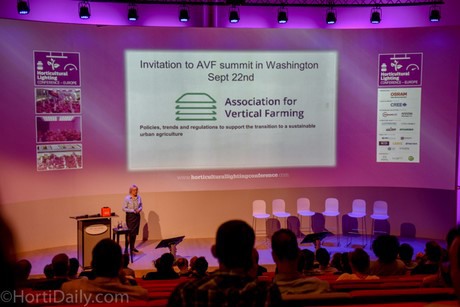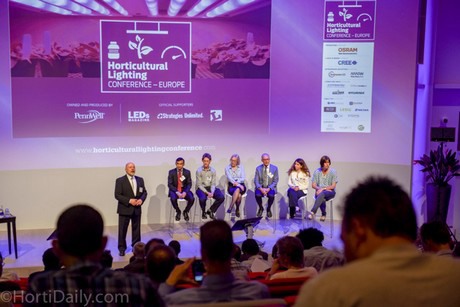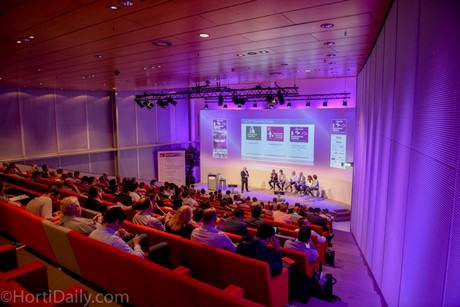
The conference, held for the first time at the Dutch High Tech Campus in Eindhoven, brought together a balanced mix of professionals with ties to the (horticultural) lighting industry. From manufacturers and developers of chips, semi-conductors, lenses and other technology related to the manufacturing of lighting systems, towards growers, researchers, breeders and consultants from the horticultural space.
We summed up some highlights of the interesting mix of presentations that shared both research and practical knowledge on the current application of LEDs in commercial horticulture:
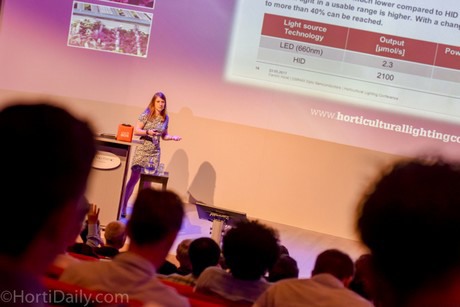
After an introduction by chairman John Bullock, the speaker program started with a look into the fundamentals of LED use in crops. Anja Dieleman of Wageningen University kicked the day off with a 'crash course in applying photobiology to create a denser, healthier, greener crop of vegetables, fruit and flowers'. Up next was Carolin Horst of Osram, who explained the basic differences between HPS and LED. For greenhouse growing, high pressure sodium remains the current major lighting source, and Horst's presentation confirmed that this will not change on a short term as a lot of R&D is still required to improve the current technical capacities and lifetime of LEDs. "Just single LEDs do not a make a whole luminaire, you need the right power supply, drivers, cooler, optics, casing, PCB, etcetera". Nonetheless, Horst explained that the LEDs do offer a lot potential advantages over HPS that will make them a more efficient and flexible lighting source for the future.
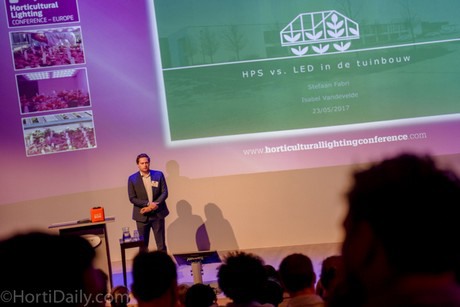
Stefaan Fabri of the Belgian Proefstation took a deeper dive into the comparison between HPS and LED with an extensive presentation of LED trials in glasshouse settings with a Merlice TOV tomato crop. The trial compared the production of tomatoes in four different lighting settings with Lemnis Oreon LEDs; HPS SON-T 180 μMol/m2/s, HPS SON-T 217 μMol/m2/s, 257 μMol/m2/s LED interlighting and 258 μMol/m2/s LED toplight. One of the interesting results, aside of the higher productions of minimal 25% in both LED settings, was that the HPS crops showed more stress. Fabri also stressed that a lot of research is still required and that the results are not a direct reason to immediately invest in LEDs. "LEDs might result in 30% lower electricity costs, but at the same time extra heat is required. That is why each situation is different as the successalso depends on local cost of energy, gas, and crop type."
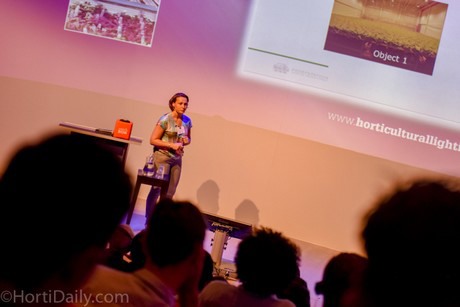
This issue was also stressed by Fabri's colleague Isabel VandeVelde, who showed that the ROI in lettuce is completely different. In her trials, 3% more natural gas was required to maintain the same temperature inside the greenhouse as in the comparison HPS greenhouse. Vandevelde showed results of 4 years of trials with use of Philips Greenpower LED Toplights on salatrio lettuce types grown on a mobile gulley system. Some results: Aside of higher rootweight and more color with LEDs, the crops are more compact, which creates a quality advantage. Lollo Rossa lettuce grows faster and showed better color under LEDs. Less tipburn in Red Oakleaf lettuce with LEDs.
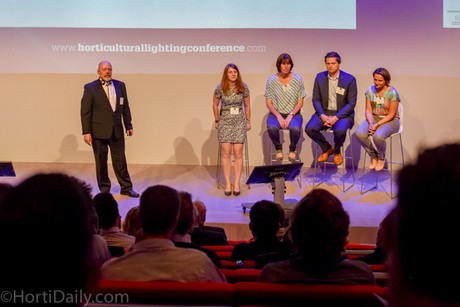
A Q&A panel discussion provided room for interesting topics such as influence of LEDs on nutrients and taste of produce.
Up next was
Phillip Davies of
Stockbridge Technology Centre. He has gained a lot of knowledge and experience on LEDs research in horticulture. STC has two impressive LED research facilities from which a lot of knowledge has been gathered over the last few years. In his presentation, Davies showed how LED spectra
can modify the morphological and chemical characteristics of plants, enabling growers to extract greater value from crop production. But he also explained that you can screw things up if you don't know what your are doing. "
More light is not always better for example.
More light means more growth but also means more cost and does not always give a better result."
Davies showed how difficult it is to determine the right lighting strategies for several crops. Bell pepper plants for example are very difficult to grow with supplemental lights. As well as this he explained the effect of blue and red ratios in several crops and the effect of far red in cucumber young plants, and how to translate all this knowledge to practice. He stressed that in this process, it is important to look at more factors than just lighting. "Do not ignore other things like CO2, media, temperature, its about the complete picture, and not just the light factor."
In the following Q&A panel, an interesting discussion on the use of parameters and metrics in plant lighting was created between the audience, researcher Phillip Davies and Dale Needham of Fourthwall and Viktor Zseller of Arrow, two manufacturers of LED lighting solutions and designs.
After a networking lunch in the exhibition hall, it was time for
Joris Van Lommel of the Belgian Proefstation to shine his light on the use of different LED spectra in hydroponic greenhouse lettuce. Interesting facts; more tipburn as a result of a wide spectra. More light results in heavier crop, but also increases risks for tipburn. More light also requires a higher investment and does not always increases production throughout the entire season. Therefore ROI should also be determined on market situation, choice of variety and the production season; in March there are less benefits from LEDs than during the winter time, so use this in your calculations.
More interesting results came from
Liesbet van Herck's research on the use of LEDs in greenhouse bell pepper crops at the Belgian
Proefstation. Her results showed that bell peppers are very difficult to grow under LED light and that the choice variety plays a crucial role. In her trials, f
our out of the five varieties gave a lower production when grown under LEDs. Only the Kaite variety was able to deliver 27% more production. This is due to the fact that a lot bell pepper varieties have not enough vigour to pull through the season, as they loose a lot power in the beginning of the lighting period. In the beginning of the crop, there was more production, but this decreased along the season.
Belgian tomato grower Marja van Dessel of Den Boschkant was so kind to share her experience with the implementation of LEDs at their large scale commercial greenhouse operations. She explained that is was not an easy decision to invest in the technology and that they had many doubts when they planned for an expansion with LEDs. Nonetheless she confirmed that they signed a contract for another installation of the third generation of Philips lights. She stressed the importance of translating all of the research knowledge into practice. "In research studies they have grown 100 kgs of tomatoes with LEDs. But those where very big, ugly, tasteless tomatoes of a very bad quality. This is not how it works in practice. We need to collaborate more with researchers to discuss more practical application of new technology to prevent these kinds of situations."
Dr Jaimin S. Patel of the Lighting Research Center (LRC) at Rensselaer Polytechnic Institute spoke about the
role that light can play in the control of plant diseases and pathogens. He took a deeper dive into the use of
UV-B and UV-C for pathogen control and the effect of short and longer exposure to them. Quick fact: An
UV-B LED does not offer the same output as an UV B Fluorescent light, so a lot of R&D still needs to be done in order to use LED technology for plant pathogen control applications, as the current designs are not sufficient enough.
The day was rounded off with a look into the future of vertical farming with an introduction by
Christine Zimmermann-Loessl, founder of the
Association for Vertical Farming. Zimmermann-Loessl provided insight into the world of city farms, urban community farming and how vertical farms can contribute to a more circular economy. If you want to learn more about vertical farming, you are invited for the AVF's annual summit, held this year in Washington on September 22.
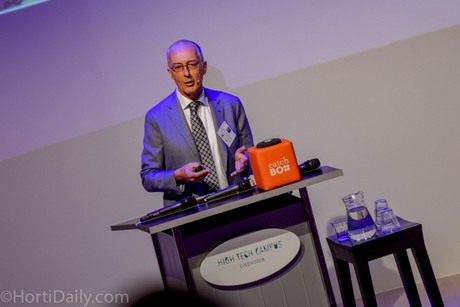
Zimmermann-Loessl was pleased to introduce
Jasper den Besten of
HAS hogeschool. Den Besten has conducted a lot of research on the commercial application of vertical farming and shared his vision on the potential of this industry by the hand of real world installations that are currently in production. He explained, that while a very interesting industry with a great potential, don't stare yourself blind at vertical farming as many parameters will determine the success. Den Besten made a comparison between vertical farming and greenhouses growing; The i
nvestment in a vertical farm is 4-10 times the investment of a greenhouse. Also operational costs are high and the exploitation costs are estimated to be five times higher than a greenhouse. The production costs of a head of lettuce is two times higher than the cost for a field grown head of lettuce.





